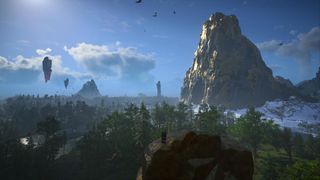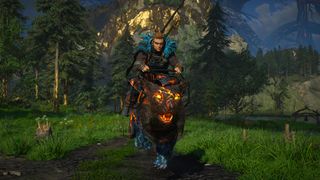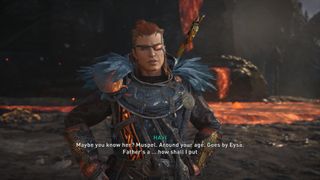Assassin's Creed Valhalla: Dawn of Ragnarok shows that the series is better without the animus
Get out of the animus and into mythology.

My least favourite thing about Assassin's Creed Valhalla is the Assassin's Creed bit. I'm over 140 hours in and at this point, I'm too afraid to ask what the hell Basim was up to, why the golden magic staff is so central to the Assassin's Creed plot or why Layla wanted to study Eivor at all. Imagine my joy, then, when I visited Asgard and Jotunheim for the first time in Valhalla. No weird subplot, no modern-day science stuff, just silly fantasy fun about vikings with nary a Marvel Cinematic Universe comparison in sight.
Valhalla is at its best when it's ignoring the trademark features of Assassin's Creed games, namely the animus and the confusing whatever going on alongside. Dawn of Ragnarok is proof that the series needs to embrace the mythology of the cultures it explores, which Ubisoft has managed well here. Sometimes games don't need any other ploys—good dialogue, fantastical lands, hard-hitting weapons and some polytheism is what makes Valhalla so special.
Dawn of Ragnarok, the latest expansion for Valhalla, is a more serious fantasy experience, but a fun one nonetheless. It's the biggest of the three expansions so far, but the only one where you play almost exclusively as Havi. While playing kingmaker in England, Ireland and France was cool, as was experiencing Ubisoft's take on actual historical events, I much prefer swanning around as the High One before scooping out one of my eyes for knowledge.

Myths and legends
This version of Odin, Havi, the All-Father—whatever you want to call him—is a more emotive version than we saw previously. It's obvious he's a pretty intense guy—you don't just let Tyr get his arm ripped off to chain up a giant wolf for no reason—and the tension within him is palpable throughout Dawn of Ragnarok. While searching for his son, Baldr, he makes it pretty clear he'd wipe out the Muspels and destroy Svartalfheim if he needs to—anything to get his beloved son back. You can see very real and raw love pouring from Havi while he searches and ultimately stumbles upon an unfortunate ending, especially when playing as female Eivor. The story invoked more emotion than half of vanilla Vahalla, and though it makes me cringe to say as such, walking out of the final battle arena to a glorious Nordic soundtrack after having obliterated Surtr was badass.
The underlying serious message in Dawn of Ragnarok is that, despite our best effort and intentions, sometimes we can't see the forest for the trees and we won't always get the outcome we desire. While that's a lesson worth learning, I've got to talk about something more important: hitting enemies with a fiery blade on a stick and how magical Svartalfheim looks.

You can climb cliffs of gold, surrounded by beautiful dwarven structures, and said dwarves will sing about you in their shelters as you perform heroic deeds. Even the Muspel fortresses, floating high in the sky, look impressively Reaper-like as they impose on the horizon. All of this pales beside Yggdrasil's foreboding roots in the background, reminding you that Svartalfheim is full of mystery and wonder. It's a welcome change to the "real" map where exploration can be summed up as: church, farm, church, sad-looking village, crumbling castle, before finding yet another church.
"...It's about a father getting revenge and destroying a big fiery giant in a mythical land. And transforming into a bird to dive-bomb assassinate people, naturally."
Despite the storyline in Dawn of Ragnarok being pretty grim, it feels oddly lighthearted. There's a lot of unintentional humour the way Eivor/Havi delivers some lines and listening to the Muspels moaning about something or other while you're stealthily moving between them is great fun. It reminds me of the NPCs in The Witcher 3, who had pretty excellent patter about current events, tutting at Geralt as he runs by while kids sing songs; it all makes these fantasy worlds more interesting. All of the realm visits have genuinely funny quests and moments, whether that's one of the Norse gods delivering a banger of a one-liner or a Jotun pretending he's a fish to protect his scaley brethren. It's just silly good fun.
The biggest gaming news, reviews and hardware deals
Keep up to date with the most important stories and the best deals, as picked by the PC Gamer team.
While historical accuracy is very exciting for someone like me—I have played a lot of Crusader Kings 3 for that exact reason—it's nice to have a Viking fantasy grounded in real Norse mythology. Thor isn't a ripped sexy dude, Loki isn't a polite Englishman with greasy hair and the Hulk hasn't appeared to smash either around. Havi is as arrogant and powerful as they come, always concerned about making sure everyone knows he's in charge. Being able to play a Viking game that doesn't have a whiff of comic books to it or solely focusing on Ragnar Lothbrok's deeds is refreshing. It's not all about raiding, pillaging or installing new leaders in Dawn Of Ragnarok; it's about a father getting revenge and destroying a big fiery giant in a mythical land. And transforming into a bird to dive-bomb assassinate people, naturally.

Digging further into Norse mythology is absolutely the right direction for Valhalla. Asgard was a pretty place with a cool rainbow bridge and had one of the more interesting storylines in the whole game, whereas Jotunheim was just a big party and you could fight a massive cat. Seeing as this is Year 2 for Valhalla, I'm hoping that we'll visit more of the nine realms and culminate Eivor's story with a big Ragnarok bang. I want more Atgeir weapons that set enemies on fire, I want the Hugr-Rip to be available in the base game, I want more armour that comes with eyepatches—you get the idea. Yes, plodding around in England and hitting posh folk with my hammer is fun, but I'd rather ride the flaming cat up a golden mountain and find drawings of tattoos everywhere somewhere other-worldly.
One unexpected twist from Dawn of Ragnarok that impacted the base game was Eivor confronting the wolf that bit her, which she fears. Until this point, the opening sequence where she gets the wolf bite on her neck felt meaningless, so to have her confront that fear and deal with her trauma feels like we're just beginning a new chapter for Eivor. This change allows her to once again experience Havi's memories in Svartalfheim, so I'm hoping to see a difference in Eivor and Havi in future updates. Maybe they'll both be a little softer, or maybe, since Basim is technically the one "playing" as Eivor now, they'll both become a pair of horrible bastards.
Basically, I want more silly Viking fun, where I can swing my silly little weapons and run around with my silly little eyepatch on. Eivor cosplaying as Havi is my favourite thing about Valhalla—seeing her swagger around as a god is a great bit of fun, especially as she's one of my favourite protagonists. The set-up at the end of Dawn of Ragnarok's story hints at several new storylines, mostly involving Loki and Fenrir ahead of Ragnarok, and I'm really looking forward to it—as long as there's no Animus or Assassin's Creed nonsense involved.
The first three games Lauren played on PC were Star Wars: X-Wing, Zoo Tycoon and Barbie Fashion Designer, which explains her love of all things space, strategy and aesthetically pleasing. Lauren recently took over as PC Gamer's Guides Editor after three years of writing many dozens of Destiny 2 guides at VG247, as well as casually trying to shoehorn in The Witcher 3 articles wherever possible. When she's not trying to force everyone to play as a Warlock in Destiny 2, Lauren is either mastering her SEO abilities to help smash the competition, or patting one of her red sons.
Most Popular


